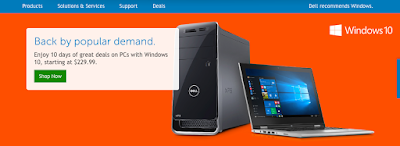Semiotics is often divided into three branches: Semantics, Syntactics, and Pragmatics. This division owes its existence to the philosophers John Locke and Charles Saunders Peirce. Semiotics explores the history of signs and symbols as a significant way of communication; in contrast to linguistics, however, semiotics also studies non-linguistics sign systems.
As you may deduce, the study of semiotics is essential to branding. What about your logo, brand, or signs is causing a catalyst-stimulus to act in the minds of your clients, and what is that stimulus?
Though most psychiatrist disagree on the efficacy of color therapy, for the sake of marketing and branding I will describe what marketers agree upon regarding which colors produce what emotional reaction in our psyche.
As you can see in the picture above, different brands would like to convey different moods in people's heads. Dell has chosen a sky blue that shows that they are dependable and trustworthy. Their slogan, "Dell, purely you", shoots for what most people want to feel when they buy a new computer, myself included.
Colors have always been a key part of the Internet; however, as the Internet has evolved into a massive business, strict color combinations or patterns have taken over and are being used in precise locations to herd you unconsciously into the direction of action and greater consumption.
Why would Blogger chose their button in orange? Apart from the obvious answer that their logo is in
orange. Could it be that, when you publish, they want you to be confident and cheerful about publishing?
The compose button on your Gmail account is hot red. Hopefully you will hit that happy trigger in your head and do it over and over again, since by composing and writing many emails you are utilizing their services.
It is simple to ask: why is this ad in this light blue color? The more you become aware, the less the ads will affect you. Or, better yet, you will start to realize whether you are reasoning based on an emotional pull or on an actual sound decision. Below, Microsoft is taking advantage of your poor understanding of emotional optics to make you jump at the idea of owning this computer. But you've got to do it soon! (The green button is a clear subliminal message that it would be healthy for you to do it as soon as possible.)
For the skeptics in the crowd that believe they are immune to the emotional effects of color, I ask you to take this Color Quiz. This test will not make you feel a certain way; it actually functions the opposite way: the colors you chose will allow the algorithm to discern how you feel at this very moment.
Since we are ball of perceptions, we must learn to pay attention to what we are up against. We are living in a world awash with corporations, a world in which corporations are actively conditioning us towards their own purposes, and these corporations ultimately want profit. There is a science to branding and it is not necessarily what looks good. There are studies conducted on the impact of human behavior and colors. How colored environments influence performance, behavior, negative and positive perceptions, moods, and emotions has been studied in-depth and is well-understood for the most part. But the prevalent use of the psychology of colors for corporate purposes need not make us saps or simple movable parts; we can become aware and resist the conditioning process.
Apart from resisting the constant flow of conditioning triggers, you can use the color wheel below to market your own products as efficiently as possible, by eliciting the responses you would like from your customers or clients. Once you've taken the Color Quiz, color profiling may make more sense to you.
To entrepreneurs, use color psychology to your advantage in your own business, or avoid it altogether at your own peril. Likewise, to individuals, it would be wise for you to understand how you are being subliminally pulled in different directions, which may shed some light into your own consumer habits, or you may simply ignore the subject making it easier for marketers to target you towards their desired actions.










No comments:
Post a Comment
Bombs away!